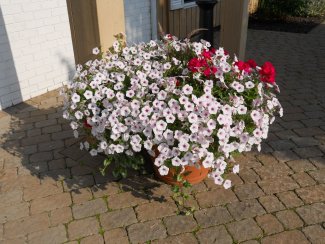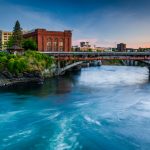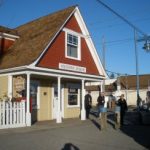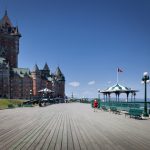
Some 80 km (50 mi) from Montreal, the Eastern Townships, bordering the U.S. states of Vermont and New Hampshire, are very accessible. Criss-crossed by a series of highways and secondary roads, which connect dozens of quaint towns and villages, the region is filled with history, fine eating places and comfortable rustic lodgings. Here, in Quebec’s most southern region, agriculture and tourism blend into a way of life. Maple groves, orchards and vineyards form the background to country-cooked meals.
The Townships, noted for their fabulous food, unique historical architecture, neat country villages and natural beauty – 80% of the Townships are wooded – are set in a North American, yet European world. This background gives them a very special appeal for both national and foreign visitors.

By the 1850’s, the French-speaking Quebecois began to settle in the area and at the turn of the 1900’s they had become the majority in most of the Townships. Today, 94% of the inhabitants are Francophone and visitors will find French-Canadian culture everywhere, giving them a feeling of traveling through France. However, in this all-encompassing French ambiance, Victorian towns with their British heritage are still much in evidence. It seems that everyone in the Townships speak French but, if called for, can easily converse in English.
A little over an hour and a half after leaving Montreal, we stopped to explore the town of Knowlton -an elegant Victorian village noted for its loyalist heritage. Located on the shores of Lake Brome, an attractive small lake, it is considered to be one of the most appealing villages in Quebec. Tourists travel here to enjoy the water activities on the lake and the beauty of the encompassing landscapes.

The next morning on our way to Rose des Champs, a tourist oriented rose farm open to the public, we drove through a countryside that was enveloped in a kaleidoscope of colours, bathing the landscape with an inviting aura. The owners, Norman Benoit and Claire Mercier, as well as their employees, immediately made us feel welcome. Benoit took us for a tour of their four acre rose farm, containing some 2,000 rose bushes made up of some 800 species. As we moved among the roses he related the history of roses and those being grown on their farm. He went on to describe the products they produce from the roses and their plans for the future.
Leaving the world of roses behind, we drove to the Bleu Lavande – a world of intoxicating lavender. Standing atop a 300 m (984 ft) high hill on the Blue Lavender Farm, just minutes from the charming town of Magog and edging the picturesque village of Fitch Bay, I breathed in the lavender-filled breezes. Like myself, here, in the midst of fields of Lavender one can, in an aroma filled dream, visualize a world of contentment, peace, freshness and calmness – a world without stress. It is an area of lavender perfume, impregnating everything around.

After meeting the charming owners, we dined, partook in a number of organized activities, then left to explore Magog – a town of 24,000 edging the striking Lake Memphremagog. For a while we roamed its beaches then toured the heart of town by foot before leaving for Estrimont Suites & Spa – our abode for the night.
With a fine evening meal and hearty breakfast at the Estrimont behind us, the next morning we drove to Sherbrooke, the largest town in the Townships. Our first stop was Parc Historique la Poudirière de Windsor. An old powder mill and now a museum, it detailed the history of gunpowder through the ages. From this factory, which once produced gunpowder for human slaughter, we left to tour the heart of the city by foot then drove to examine the fine murals for which the city is noted. We rested for a while in the new Grand Times Hotel – an excellent abode but strangely with no restaurant.

As soon as we sat down, smiling waiters decked out in traditional caps and uniforms began to take our orders and soon were serving us dinner on English china and silver cutlery. Shortly thereafter, while passing through an idyllic countryside, we began to enjoy a first class meal, worthy of the finest tables – this day serving either large shrimps or stuffed loin of pork with all their trimmings as the main course. At the same time as we ate, my seat companion described the scene well when she remarked, “We dine in luxury, surrounded by a serene enchanted landscape.”
The unforgettable exquisite culinary adventure, the scenic-charming view of the countryside, the enthralling entertainment and the friendliness of the fellow passengers, as well as the smiling crew members, all combined to make for a wonderful three and a half hour train journey. Andre L’Esperance and Donald Thompson have created a pleasure excursion train for tourists and locals alike – the pride of the Eastern Townships of Quebec.
For the final day, we first toured the Abbaye St. Benoit-du-Lac – an impressive Benedictine monk’s monastery overlooking Lake Memphremagog, then stopped at Savons des Cantons – Quebec’s top soap interpretation centre. Here, an artisan taught us how to make our own soap and we then bought beautiful soap gifts at the boutique before leaving.

That night in my comfortable bed, I thought about our four day rambling in Quebec’s Eastern Townships. Our sampling of their attributes had been like sirens, luring the wayfarer into their loving embrace. The panorama of forests, orchards, and flowers everywhere hiding charming farmhouses, round barns, covered bridges and distinctive villages had left in my mind a rustic scene of rural enchantment and encompassed me in a feeling of elation.

How to Get There:
The Townships are easily accessible from Montreal and Quebec City as well as from the US bordering states of Vermont and New Hampshire by Autoroute 10 and 55. Also, there are many organized excursions offered by tour companies throughout the region.
Where to Stay and Dine:
The Townships have developed a reputation for their tourist abodes, which offer some of the best accommodations and dining in the world. Form among the abodes that we stayed at and dined at were:
Auberge Quilliams:
Here one can dine on fine lunches and dinners in a relaxed atmosphere surrounded by a wondersous scenic countryside. 572, chemin Lakeside, Lac-Brome, (Quebec) J0E 1R0. Tel: (450) 243-0404 / (888) 9220404. Fax: (450) 243-0770.
Estrimont Suites & Spa:
Ideally located charming Magog region only moments from a variety of recreational activities such as Cross-country skiings, sledding, fishing and much more
44, avenue de l’Auberge,Orford (Quebec, Canada), J1X 6J3. Tel: 819 843-1616. Toll free: 1 800 567-7320. Fax: 819 843-4909. E-mail: reservations@estrimont.ca Website: www.estrimont.ca
Grand times Hotel:
A new-just openned hotel Located in downtown Sherbrooke in the business sector with sleek style New York International Zen-flavored, offering magnificent views of the edging Lac des Nations, but no restaurants. rue Belvedere Sud 1, rue Belvedere Sud Sherbrooke, Qc J1H 0G8 Sherbrooke, QC J1H 0G8, Tel:819-575-2222 or 888-999-3499 Fax: 819-575-5500. E-mail: infosherbrooke@timeshotel.ca Website: www.timeshotel.ca
For More Information:
Tel: 1 (800) 355-5755, or see Web Site: www.cantonsdelest.com







Leave a Reply